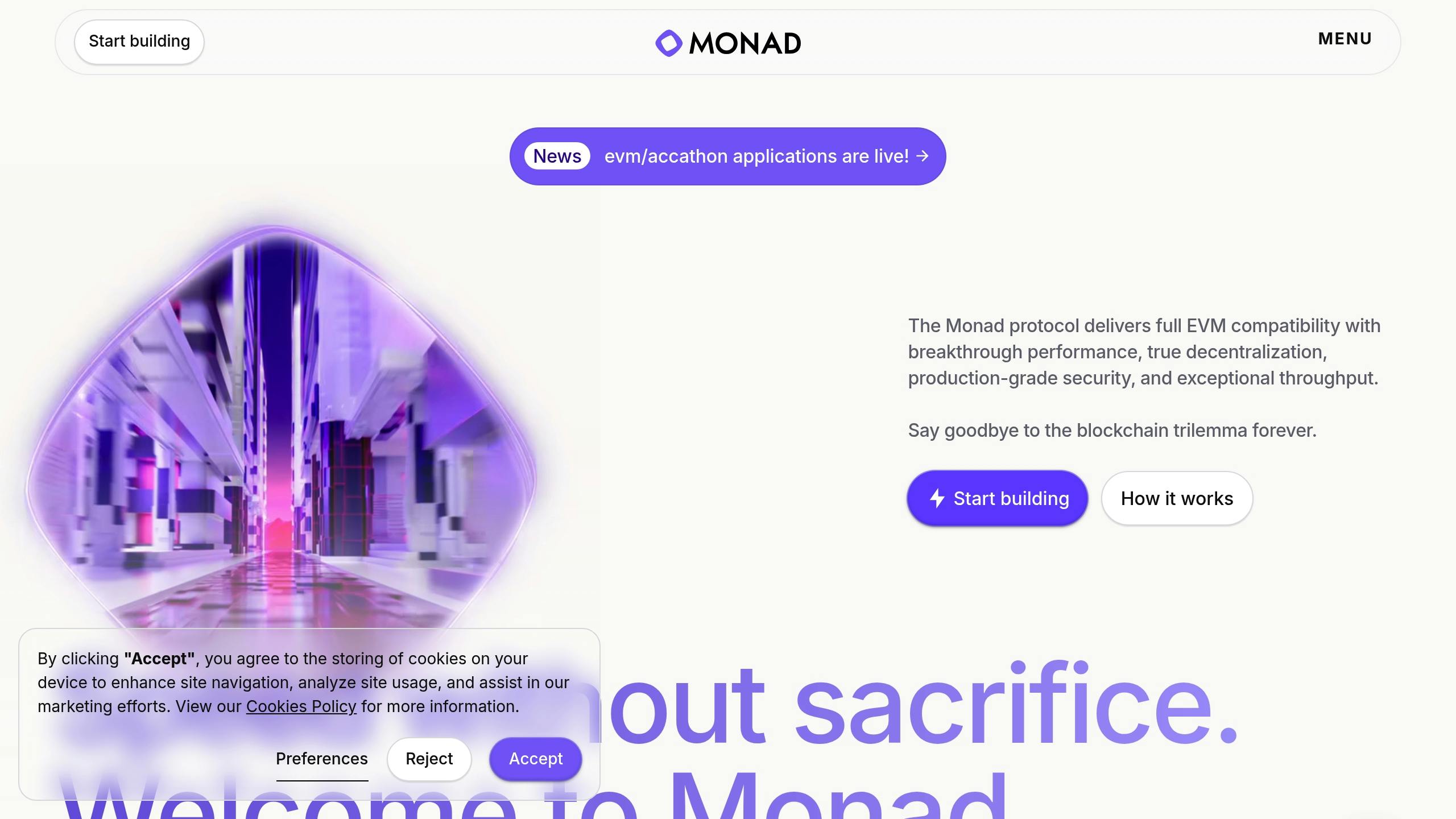Monad is a Layer 1 blockchain that delivers 10,000 transactions per second (TPS), 1-second block times, and instant finality, making it 1,000 times faster than Ethereum. It achieves this through features like parallel execution, MonadDB, and MonadBFT for secure, high-speed performance. Fully compatible with Ethereum, Monad enables seamless migration for developers and traders.
Key Features:
- Speed: 10,000 TPS, 1-second block times
- Gas Fees: Near-zero costs
- Compatibility: Full EVM support for Ethereum tools like Solidity and MetaMask
- Use Cases: High-frequency trading, complex DeFi protocols, order book DEXs, and cross-chain apps
Quick Comparison:
| Feature | Monad | Ethereum | Solana |
|---|---|---|---|
| Transaction Speed | 10,000 TPS | 15-30 TPS | Up to 65,000 TPS |
| Block Time | 1 second | 12-14 seconds | 400 milliseconds |
| Finality | Instant | ~6 minutes | Near-instant |
| Gas Fees | Near-zero | Variable | Low |
| EVM Compatibility | Full | Native | Custom |
Monad is designed for DeFi scalability, offering tools like Kuru DEX for advanced trading and LayerZero integration for cross-chain interoperability. With $19M in funding and a roadmap to expand its ecosystem, Monad is set to redefine blockchain performance for institutional-grade applications.
Monad EXPLAINED – Technical Overview and Core Features

Technical Features
Monad’s system introduces key advancements that improve blockchain performance through parallel transaction processing, advanced security measures, and full compatibility with Ethereum’s Virtual Machine (EVM). These features work together to deliver high throughput without compromising decentralization, enabling the high-frequency trading scenarios discussed earlier.
How Parallel Execution Works
Monad’s parallel execution processes multiple transactions at the same time, unlike traditional sequential methods. A static analyzer predicts dependencies, while a conflict resolver ensures reliability by selectively re-executing transactions when needed.
| Component | Function |
|---|---|
| Static Analyzer | Detects transaction dependencies |
| Parallel Processing | Runs non-conflicting transactions together |
| Conflict Resolution | Handles re-execution of affected transactions |
This method significantly boosts transaction throughput, making it ideal for the institutional-grade trading applications outlined in the DeFi section.
MonadBFT Security Protocol
MonadBFT is a consensus mechanism designed to handle Byzantine faults. It separates transaction execution from finalization, allowing for:
- Transactions to be processed asynchronously
- Hundreds of validation nodes to operate simultaneously
- Instant finality of transactions
The system ensures security even under partially synchronized network conditions, while still achieving high performance.
"MonadBFT’s architecture demonstrates that high performance and strong security guarantees aren’t mutually exclusive in blockchain systems", states a technical review by DAIC Capital [4].
EVM Support and Development
Monad replicates Ethereum’s execution environment, making it fully compatible with existing Ethereum tools. This allows traders to migrate their tools easily and developers to work with familiar systems:
| Tool | Usage |
|---|---|
| Solidity | Writing smart contracts |
| Hardhat/Truffle | Contract deployment |
| Web3.js/Ethers.js | Building frontends |
| MetaMask | Managing wallets |
This compatibility simplifies the transition for traders accustomed to Ethereum-based decentralized exchanges (DEXs).
Monad also integrates Ethereum’s Merkle Patricia Trie through MonadDB, enabling efficient support for complex DeFi operations while maintaining high performance.
Platform Tools and Services
Monad’s ecosystem is designed to deliver top-tier performance through a highly optimized infrastructure.
DEX Platforms
Kuru, built on Monad’s advanced order book capabilities, offers a fully on-chain order book decentralized exchange (DEX) [5]. This platform provides sophisticated trading features while ensuring compatibility with other DeFi applications. Key features include:
| Feature | Description |
|---|---|
| Order Types | Supports limit orders, stop-loss, and market orders |
| Trading Speed | Handles up to 10,000 transactions per second (TPS) |
| Integration | Fully compatible with DeFi protocols |
| Margin Trading | Offers both cross and isolated margin options |
Technical Infrastructure
Monad’s technical foundation ensures smooth and efficient operations through the following components:
Mozi Wallet Integration
The Mozi Wallet [3] connects users to Monad’s ecosystem, incorporating MonadBFT’s secure transaction model. With this wallet, users can manage tokens, interact with decentralized apps (dApps), and participate in governance activities – all within a single interface.
Cross-Chain Connectivity
Thanks to LayerZero integration [3], Monad supports cross-chain transfers, smart contract interoperability, and shared liquidity pools, making it easier to interact across multiple blockchain networks.
Common Applications
Monad powers a variety of applications that highlight its capabilities:
FortyTwo Protocol
Using Monad’s parallel execution engine, the FortyTwo Protocol [5] facilitates a decentralized AI system for collaborative reasoning.
Kizzy Platform
Kizzy leverages Monad’s low-latency infrastructure to deliver real-time social trading experiences. It combines prediction markets with a social gaming platform for interactive user engagement [5].
sbb-itb-dd9e24a
Leverage Trading Guide
Leverage Trading Basics
Leverage trading allows you to amplify your trading positions using borrowed funds. With Monad’s high-performance infrastructure, traders can choose between isolated margin (where risk is limited to a single trade) and cross margin (where your entire account balance serves as collateral). For example, with 10x leverage, a $1,000 deposit lets you control a $10,000 position [1].
| Margin Type | Description | Risk Level |
|---|---|---|
| Isolated Margin | Allocates a set amount to a single position | Lower (losses limited to that amount) |
| Cross Margin | Uses your entire account as collateral | Higher (all positions share the risk) |
Smart Risk Management Tips
To keep risks in check, beginners should stick to 2x-3x leverage, use stop-loss orders set above liquidation points, and limit single-trade exposure to 2% of their total capital [2][5][7].
DEX vs CEX Comparison
Monad-native DEXs, like Kuru, offer unique benefits compared to centralized exchanges (CEXs) when it comes to leverage trading.
Why Security Matters
Trading on Monad-native DEXs gives you control over your assets through smart contracts. For instance, during the 2022 FTX collapse, CEX users lost access to their funds, while DEX users retained control of their assets [1][6].
How DEXs and CEXs Compare
| Feature | Monad-based DEXs | Centralized Exchanges |
|---|---|---|
| Order Execution | Transparent, smart contract-based | Faster but less transparent |
| Maximum Leverage | Up to 10x | Over 100x |
| Asset Control | Non-custodial wallets | Exchange-controlled wallets |
| Trading Fees | Generally higher due to blockchain costs | Lower fees |
| KYC Requirements | None | Required for higher trading limits |
Monad’s DEX platforms, like Kuru, combine these benefits with high-speed performance, making them ideal for advanced trading strategies.
For example, traders can set up automated strategies like ETH/USDT grid orders between $2,000 and $2,200 with $20 intervals, taking advantage of market volatility [2][5].
Market Position and Growth
Blockchain Platform Comparison
Monad stands out in the blockchain space by delivering higher throughput compared to Ethereum while maintaining better decentralization than Solana. Here’s a quick breakdown of key metrics:
| Feature | Monad | Ethereum | Solana |
|---|---|---|---|
| Speed Metrics | 1s blocks, instant finality | 12-14s blocks, ~6m finality | 400ms blocks, near-instant |
| Transaction Speed | 10,000 TPS | 15-30 TPS | Up to 65,000 TPS |
| Cost Predictability | High | Variable | High |
| Developer Migration Ease | Native | Native | Custom |
Monad’s architecture allows Ethereum contracts to be directly ported over, thanks to its EVM compatibility. This means developers can seamlessly deploy Ethereum-native trading strategies on Monad. By February 2024, more than 80 independent protocols and dApps had already joined the platform, with projections of 150-200 projects by the mainnet launch [4]. This growth aligns with the platform’s focus on high-frequency trading infrastructure.
Upcoming Features
Monad’s roadmap highlights plans to expand its ecosystem and improve interoperability. For instance, Wormhole protocol support will enhance connectivity with other networks like Solana, broadening asset availability for platforms such as Kuru DEX [4].
Key technical upgrades include:
| Feature | Benefit |
|---|---|
| Asynchronous Execution | Boosts scalability by decoupling consensus performance |
Post-mainnet launch, Monad will focus on building critical DeFi infrastructure, including:
- Decentralized limit order book exchanges
- NFTFi integration
- Perpetual futures trading infrastructure to support leveraged trading
The testnet is expected to go live in late 2024, with the mainnet launch scheduled for early 2025 [4]. Monad’s architecture is designed to scale efficiently as the network grows [2].
Summary
Monad’s technical architecture offers clear advantages for decentralized finance (DeFi) applications. By achieving sub-second finality and high throughput, it tackles the latency issues common in many decentralized exchange (DEX) leverage trading platforms. Importantly, these performance improvements are paired with a strong security framework, ensuring fund safety – an essential feature for institutional-grade trading.
The platform combines Ethereum compatibility with performance levels that rival centralized systems. Its Optimistic Parallel Execution stands out as a game-changer, especially for high-frequency trading use cases.
Developers can leverage full EVM equivalence while benefiting from throughput typically seen in centralized systems. This focus on performance, security, and developer experience has driven notable ecosystem growth, highlighting Monad’s potential as a key infrastructure layer for DeFi.
